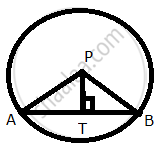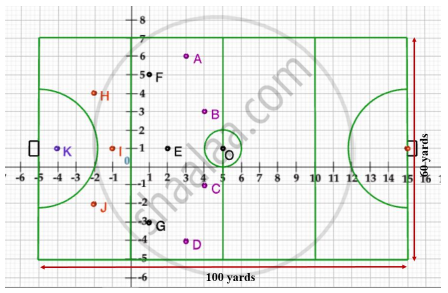Advertisements
Advertisements
प्रश्न
Find the distance between the following pairs of points:
(a, b), (−a, −b)
Find the distance between the following pairs of points:
(-a, -b) and (a, b)
उत्तर
Distance between (a, b) and (−a, −b) is given by
l = `sqrt((a-(-a))^2+(b-(-b))^2)`
= `sqrt((2a)^2 + (2b)^2)`
= `sqrt(4a^2+4b^2)`
= `2sqrt(a^2 + b^2)`
संबंधित प्रश्न
If A(5, 2), B(2, −2) and C(−2, t) are the vertices of a right angled triangle with ∠B = 90°, then find the value of t.
If two vertices of an equilateral triangle be (0, 0), (3, √3 ), find the third vertex
Find the coordinates of the centre of the circle passing through the points (0, 0), (–2, 1) and (–3, 2). Also, find its radius.
In a classroom, 4 friends are seated at the points A, B, C and D as shown in the following figure. Champa and Chameli walk into the class and after observing for a few minutes, Champa asks Chameli, “Don’t you think ABCD is a square?” Chameli disagrees.
Using distance formula, find which of them is correct.

Find the values of y for which the distance between the points P (2, -3) and Q (10, y) is 10 units.
If Q (0, 1) is equidistant from P (5, − 3) and R (x, 6), find the values of x. Also find the distance QR and PR.
Find the distance between the following pair of points:
(-6, 7) and (-1, -5)
Find the distance between the following pair of points:
(a+b, b+c) and (a-b, c-b)
Two opposite vertices of a square are (-1, 2) and (3, 2). Find the coordinates of other two
vertices.
Find all possible values of x for which the distance between the points
A(x,-1) and B(5,3) is 5 units.
Find value of x for which the distance between the points P(x,4) and Q(9,10) is 10 units.
Using the distance formula, show that the given points are collinear:
(-1, -1), (2, 3) and (8, 11)
Determine whether the points are collinear.
L(–2, 3), M(1, –3), N(5, 4)
If A and B are the points (−6, 7) and (−1, −5) respectively, then the distance
2AB is equal to
Find the value of y for which the distance between the points A (3, −1) and B (11, y) is 10 units.
Find the distance between the following pairs of point in the coordinate plane :
(7 , -7) and (2 , 5)
Find the distance of the following point from the origin :
(6 , 8)
Find the distance between P and Q if P lies on the y - axis and has an ordinate 5 while Q lies on the x - axis and has an abscissa 12 .
Prove that the following set of point is collinear :
(5 , 1),(3 , 2),(1 , 3)
Find the coordinate of O , the centre of a circle passing through A (8 , 12) , B (11 , 3), and C (0 , 14). Also , find its radius.
P(5 , -8) , Q (2 , -9) and R(2 , 1) are the vertices of a triangle. Find tyhe circumcentre and the circumradius of the triangle.
Prove that the points (0 , 2) , (1 , 1) , (4 , 4) and (3 , 5) are the vertices of a rectangle.
From the given number line, find d(A, B):

Find the distance between the following pairs of points:
(-3, 6) and (2, -6)
A point A is at a distance of `sqrt(10)` unit from the point (4, 3). Find the co-ordinates of point A, if its ordinate is twice its abscissa.
A point P lies on the x-axis and another point Q lies on the y-axis.
Write the abscissa of point Q.
Point P (2, -7) is the center of a circle with radius 13 unit, PT is perpendicular to chord AB and T = (-2, -4); calculate the length of: AT

KM is a straight line of 13 units If K has the coordinate (2, 5) and M has the coordinates (x, – 7) find the possible value of x.
By using the distance formula prove that each of the following sets of points are the vertices of a right angled triangle.
(i) (6, 2), (3, -1) and (- 2, 4)
(ii) (-2, 2), (8, -2) and (-4, -3).
If the point (x, y) is at equidistant from the point (a + b, b – a) and (a-b, a + b). Prove that ay = bx.
Find distance between point Q(3, – 7) and point R(3, 3)
Solution: Suppose Q(x1, y1) and point R(x2, y2)
x1 = 3, y1 = – 7 and x2 = 3, y2 = 3
Using distance formula,
d(Q, R) = `sqrt(square)`
∴ d(Q, R) = `sqrt(square - 100)`
∴ d(Q, R) = `sqrt(square)`
∴ d(Q, R) = `square`
Show that the point (11, – 2) is equidistant from (4, – 3) and (6, 3)
The distance between the points (0, 5) and (–5, 0) is ______.
AOBC is a rectangle whose three vertices are A(0, 3), O(0, 0) and B(5, 0). The length of its diagonal is ______.
A circle drawn with origin as the centre passes through `(13/2, 0)`. The point which does not lie in the interior of the circle is ______.
Case Study -2
A hockey field is the playing surface for the game of hockey. Historically, the game was played on natural turf (grass) but nowadays it is predominantly played on an artificial turf.
It is rectangular in shape - 100 yards by 60 yards. Goals consist of two upright posts placed equidistant from the centre of the backline, joined at the top by a horizontal crossbar. The inner edges of the posts must be 3.66 metres (4 yards) apart, and the lower edge of the crossbar must be 2.14 metres (7 feet) above the ground.
Each team plays with 11 players on the field during the game including the goalie. Positions you might play include -
- Forward: As shown by players A, B, C and D.
- Midfielders: As shown by players E, F and G.
- Fullbacks: As shown by players H, I and J.
- Goalie: As shown by player K.
Using the picture of a hockey field below, answer the questions that follow:

What are the coordinates of the position of a player Q such that his distance from K is twice his distance from E and K, Q and E are collinear?
Show that points A(–1, –1), B(0, 1), C(1, 3) are collinear.
